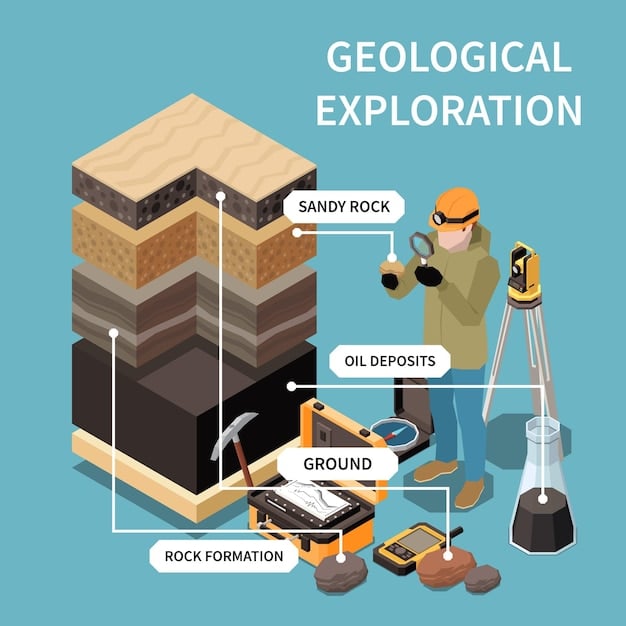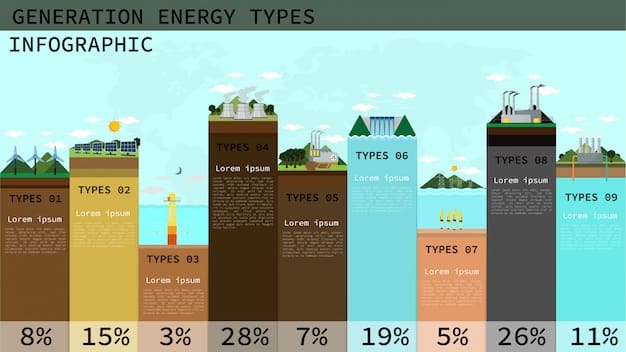The Future of Geothermal Energy in the US: Enhanced Geothermal Systems (EGS) by 2030

The Future of Geothermal Energy in the US: Exploring Enhanced Geothermal Systems (EGS) by 2030 reveals the potential of EGS to tap into vast, previously inaccessible geothermal resources, offering a sustainable and clean energy solution for the nation’s future energy needs by 2030.
The potential of The Future of Geothermal Energy in the US: Exploring Enhanced Geothermal Systems (EGS) by 2030 to significantly transform America’s energy landscape, promising a cleaner and more sustainable future, is noteworthy
Understanding Enhanced Geothermal Systems (EGS)
Enhanced Geothermal Systems (EGS) represent a groundbreaking approach to geothermal energy extraction. Unlike traditional geothermal plants that rely on naturally occurring hydrothermal resources, EGS technology allows us to access geothermal energy in areas where hot, dry rocks exist deep underground but lack the water and permeability needed to produce steam.
This innovative method essentially creates artificial geothermal reservoirs by injecting water into these hot, dry rocks, fracturing them, and then extracting the heated water as steam to generate electricity. EGS holds immense potential because it significantly expands the geographic availability of geothermal energy, making it accessible in regions previously considered unsuitable for geothermal development.
How EGS Works
The EGS process involves several key steps:
- Site Selection: Identifying locations with hot, dry rocks at a reachable depth.
- Well Drilling: Drilling injection and production wells into the target rock formation.
- Hydraulic Fracturing: Injecting high-pressure water to create fractures and increase permeability within the rock.
- Circulation: Injecting water through the fractures, allowing it to heat up as it circulates through the hot rocks.
- Steam Production: Extracting the heated water as steam to power turbines and generate electricity.
Benefits Compared to Traditional Geothermal
EGS offers several advantages over traditional geothermal systems:
- Wider Geographic Applicability: EGS can be implemented in many more locations as it doesn’t rely on naturally occurring hydrothermal resources.
- Increased Resource Potential: EGS taps into a much larger geothermal resource base, significantly increasing the potential for geothermal energy production.
- Reduced Environmental Impact: EGS can have a smaller environmental footprint compared to other energy sources, particularly when best practices are implemented.
In conclusion, Enhanced Geothermal Systems unlock the vast potential of geothermal energy by creating artificial reservoirs in hot, dry rocks, offering a sustainable and geographically versatile energy solution compared to traditional geothermal methods.

The Current State of EGS Technology in the US
While EGS technology holds immense promise, it’s still in the relatively early stages of deployment in the United States. There have been several pilot projects and research initiatives aimed at demonstrating the feasibility and viability of EGS, but widespread commercial adoption is yet to occur.
Currently, the US Department of Energy (DOE) is playing a key role in advancing EGS technology through research and development funding, collaborative projects, and technology demonstrations. These efforts are focused on addressing technical challenges, reducing costs, and improving the performance and reliability of EGS systems.
Key EGS Projects in the US
Several notable EGS projects have been undertaken in the US, including:
- The Newberry EGS Demonstration Project: Located in Oregon, this project aims to demonstrate the long-term viability of EGS in a volcanic environment.
- The Fallon FORGE Site: Located in Nevada, this site serves as a dedicated field laboratory for EGS research and development.
- Various university-led research projects: Universities across the country are conducting research on various aspects of EGS, from reservoir characterization to enhanced fracturing techniques.
Challenges and Opportunities
Despite the progress made, EGS still faces several challenges:
- High Upfront Costs: The initial investment required for drilling, fracturing, and infrastructure development can be substantial.
- Technical Risks: Ensuring successful fracturing, maintaining reservoir permeability, and managing induced seismicity remain technical hurdles.
- Regulatory and Permitting Issues: Navigating regulatory frameworks and obtaining necessary permits can be complex and time-consuming.
However, overcoming these challenges presents significant opportunities for innovation and growth in the geothermal industry. Continued research, technological advancements, and supportive policies can pave the way for wider adoption of EGS in the US energy mix.
In summary, while EGS technology is still in its early stages of deployment in the US, ongoing research, pilot projects, and government support are driving progress, but challenges related to costs, technical risks, and regulatory issues need to be addressed for widespread adoption.
Potential Impact of Enhanced Geothermal Systems by 2030
By 2030, Enhanced Geothermal Systems (EGS) have the potential to significantly impact the US energy landscape. With continued research, development, and deployment efforts, EGS could contribute substantially to the nation’s clean energy goals and reduce reliance on fossil fuels.
One of the key potential impacts is the diversification of the US energy mix. By tapping into vast, previously inaccessible geothermal resources, EGS could provide a stable and reliable source of baseload power, complementing other renewable energy sources like solar and wind.

Contribution to Renewable Energy Goals
EGS can play a crucial role in achieving ambitious renewable energy goals set by the US government and individual states. By 2030, EGS could contribute significantly to the overall share of renewable energy in the electricity sector, helping to meet targets for carbon emissions reduction and climate change mitigation.
Economic Benefits
The development and deployment of EGS can create new economic opportunities, including:
- Job Creation: EGS projects can generate jobs in drilling, construction, manufacturing, and operation and maintenance.
- Local Economic Development: EGS projects can bring economic benefits to rural communities through increased tax revenues and local spending.
- Technological Innovation: EGS advancements can spur innovation in related fields, creating new business and export opportunities.
Energy Security
EGS can enhance US energy security by providing a domestic source of clean energy that is not subject to price volatility or geopolitical risks associated with fossil fuels. This enhanced energy independence strengthens the nation’s economy and resilience.
EGS has the potential to significantly transform the US energy landscape by 2030, contributing to renewable energy goals, creating economic opportunities, and enhancing energy security through a stable and reliable source of baseload power.
Policy and Regulatory Framework for EGS Development
The development of Enhanced Geothermal Systems (EGS) in the US is heavily influenced by the existing policy and regulatory framework. Supportive policies and streamlined regulations are essential to encourage investment, reduce barriers to entry, and ensure the sustainable and responsible development of EGS resources.
At the federal level, the US Department of Energy (DOE) plays a key role in providing funding for EGS research, development, and demonstration projects. Additionally, tax incentives and loan guarantee programs can help to reduce the financial risks associated with EGS development.
Federal Initiatives
- DOE Geothermal Technologies Office: Supports research, development, and demonstration of EGS technologies.
- Tax Credits: Offers tax credits for renewable energy production, including geothermal.
- Loan Guarantee Programs: Provides loan guarantees to reduce financial risks for EGS projects.
State Regulations
State governments also play a critical role in regulating EGS development. Regulations typically cover:
- Permitting: Requirements for obtaining permits for drilling, fracturing, and operation of EGS facilities.
- Environmental Protection: Regulations to protect water resources, air quality, and biodiversity.
- Induced Seismicity: Monitoring and mitigation measures to address potential induced seismicity risks.
Streamlining the Regulatory Process
To facilitate EGS development, it is important to streamline the regulatory process and reduce unnecessary permitting delays. Clear and consistent regulations can provide greater certainty for developers and investors, encouraging investment in EGS projects.
A supportive policy and regulatory framework is crucial for the successful development of EGS in the US, providing incentives, reducing risks, and ensuring the sustainable and responsible use of geothermal resources.
Technical Challenges and Innovations in EGS
Enhanced Geothermal Systems (EGS) technology faces several technical challenges that need to be addressed to improve its economic viability and widespread adoption. However, ongoing research and development efforts are driving innovation and leading to breakthroughs that can overcome these challenges.
One of the main challenges is creating and maintaining permeability in the fractured rock formation. Successful EGS requires a network of interconnected fractures that allow for efficient water circulation and heat extraction.
Fracture Stimulation and Management
Techniques for fracture stimulation and management are crucial for EGS. These include:
- Hydraulic Fracturing Optimization: Developing techniques to create more effective and predictable fracture networks.
- Proppant Use: Using proppants to keep fractures open and maintain permeability over time.
- Reservoir Modeling: Improving reservoir models to better understand and predict fluid flow and heat transfer.
Managing Induced Seismicity
Induced seismicity, or earthquakes triggered by EGS operations, is a concern that needs to be carefully managed. Mitigation strategies include:
- Advanced Monitoring: Implementing sophisticated monitoring systems to detect and locate microseismic events.
- Pressure Management: Carefully controlling injection pressures to minimize the risk of triggering larger earthquakes.
- Adaptive Management: Developing adaptive management strategies to respond to changing seismic conditions.
Addressing technical challenges through innovation is crucial to realizing the full potential of EGS and ensuring its long-term sustainability and economic viability.
In conclusion, innovative solutions are essential to address the issues that EGS technology encounters, such as fracture stimulation, administration, and induced seismicity. Continuous development and research will promote EGS’s ongoing viability and long-term sustainability.
Future Outlook for Enhanced Geothermal Systems in the US
The future outlook for Enhanced Geothermal Systems (EGS) in the US is promising, with significant potential for growth and expansion in the coming years. As technology advances, costs decline, and supportive policies are implemented, EGS could become a major contributor to the US energy mix.
By 2030 and beyond, EGS could provide a significant portion of the nation’s electricity needs, helping to meet renewable energy goals and reduce carbon emissions. The development of EGS resources could also create new economic opportunities in rural communities and enhance US energy security.
Key Trends to Watch
Several key trends are likely to shape the future of EGS in the US:
- Technological Advancements: Continued advancements in drilling, fracturing, and reservoir management technologies.
- Cost Reductions: Efforts to reduce the costs of EGS development, making it more competitive with other energy sources.
- Policy Support: Government policies that incentivize EGS development and provide regulatory certainty.
Potential for Growth
The potential for EGS growth in the US is substantial. With vast geothermal resources located across the country, EGS could be deployed in many different regions, providing clean and reliable energy to millions of Americans. Expanding EGS infrastructure will increase demand for skilled labor in the US.
The future for EGS in the US is reliant on growing demand and infrastructure development with increased policy support, which will continue to drive EGS technology forward.
| Key Point | Brief Description |
|---|---|
| 🌍 EGS Definition | Enhanced Geothermal Systems create artificial geothermal reservoirs in hot, dry rocks. |
| 💡 US Potential | EGS could significantly diversify the US energy mix and reduce reliance on fossil fuels by 2030. |
| 🛠️ Key Challenges | EGS faces challenges including high costs, technical risks, and regulatory hurdles. |
| 📈 Growth Factors | Technological advancements, cost reductions, and policy support are key for EGS growth. |
Frequently Asked Questions
▼
EGS are engineered reservoirs created to extract heat from hot, dry rocks deep underground. Unlike traditional geothermal, EGS doesn’t require naturally occurring water or steam.
▼
EGS can be implemented in many locations where hot, dry rocks exist at reachable depths. This expands geothermal potential beyond traditional hydrothermal areas.
▼
Challenges include high upfront costs, technical risks associated with fracturing, and managing potential induced seismicity (earthquakes).
▼
The US Department of Energy (DOE) provides funding for research, development, and demonstration projects, supporting EGS technology advancement.
▼
By 2030, EGS could significantly diversify the US energy mix, contributing to renewable energy goals and reducing reliance on fossil fuels.
Conclusion
In conclusion, the future of geothermal energy in the US hinges significantly on the successful development and deployment of Enhanced Geothermal Systems (EGS). While challenges remain, ongoing research, supportive policies, and technological advancements point towards a promising future where EGS can play a crucial role in meeting the nation’s clean energy goals and enhancing energy security, hopefully by 2030.





